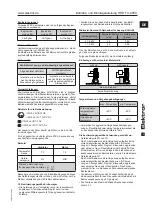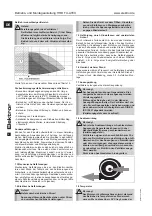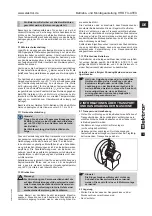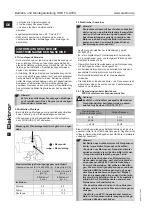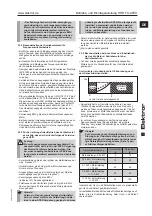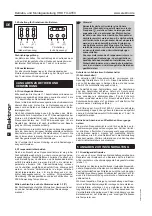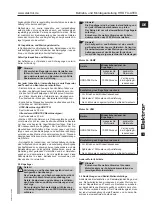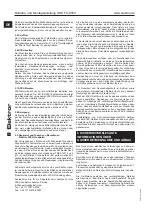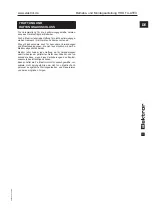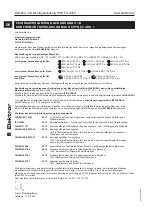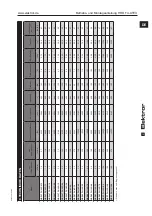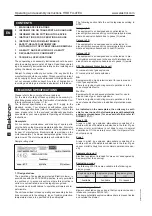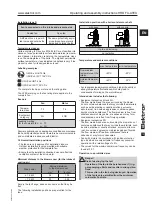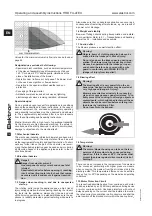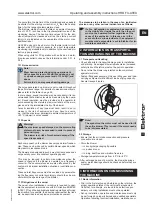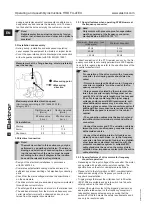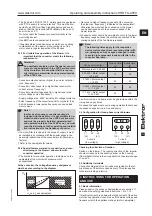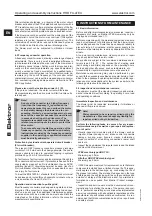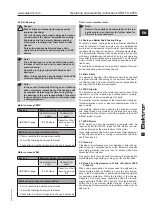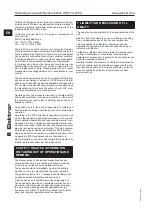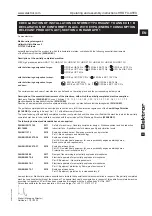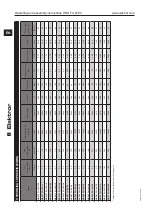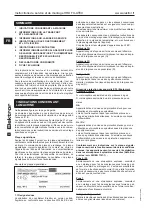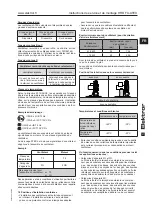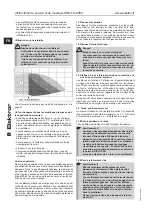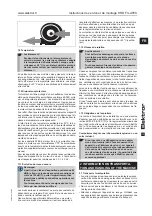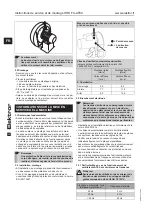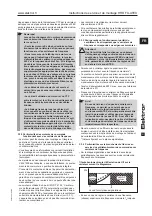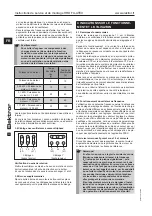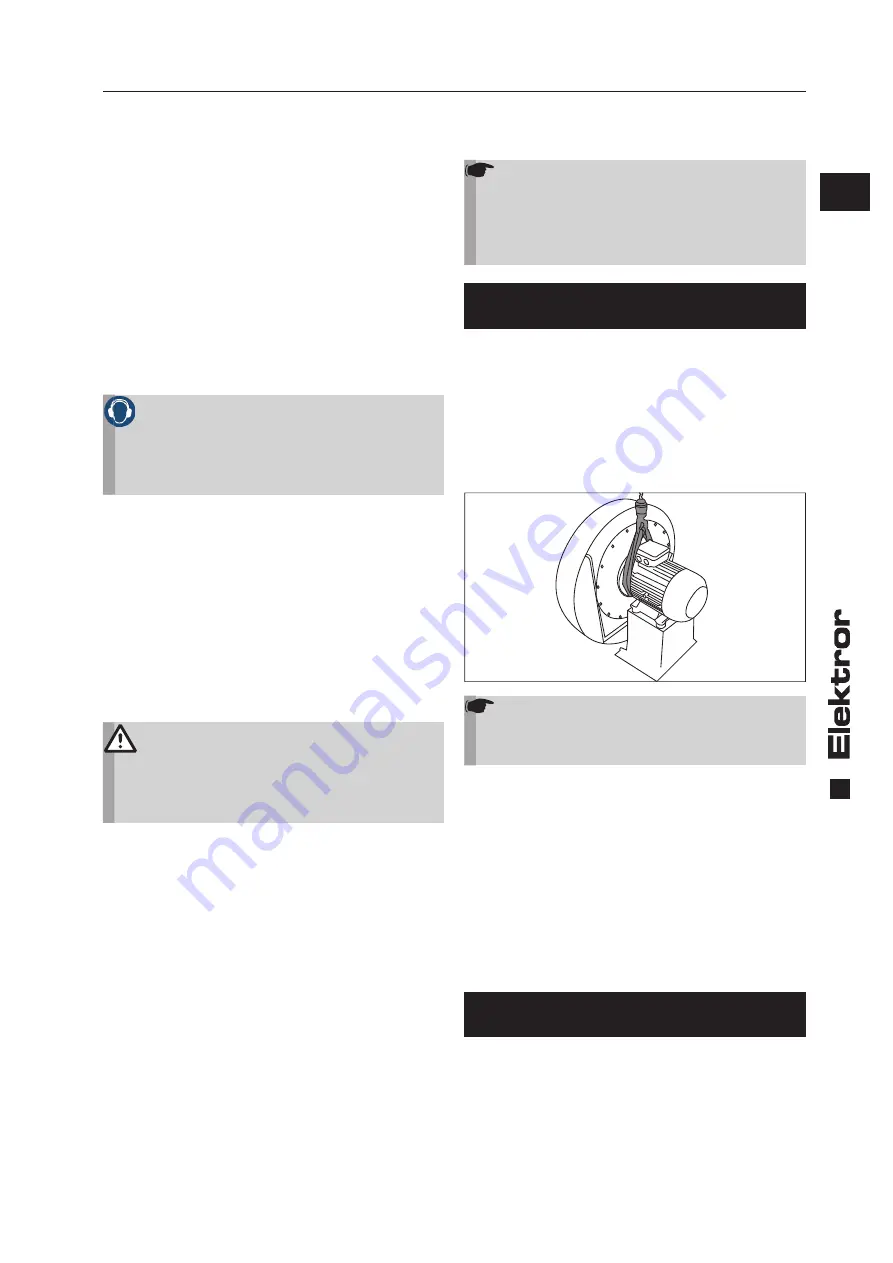
17
EN
Operating and assembly instructions HRD FU-ATEX
www.elektror.com
9016330 01.20/08
To ensure this, the trip time of the monitoring device needs to
be shorter for the start-up current ratio I
A
/I
N
than the heat-up
time t
E
for the respective temperature class.
The trip time, starting from cold state at an ambient tempera-
ture of +20 °C, is shown in the trip characteristic curve of the
monitoring device. The heat-up time values tE for the indi-
vidual temperature classes as well as the start-up current
ratio I
A
/I
N
are indicated on the nameplate of the motor or an
additional label.
On ATEX units with Ex eb motor, the thermal motor circuit-
breaker with PTC-resistor sensors for direct temperature
monitoring is permissible only in addition to the overload pro-
tection (upon request).
When using units for FC operation with an Ex db eb motor,
it is also essential to observe the information under 3.3.1. to
3.3.4.
1.11 Noise emission
Note!
Wear hearing protection during operation at a
daily exposure level of 80 dB(A) and above, and/
or a peak sound pressure level of 135 dB(C) and
above.
Failure to do so may cause hearing damage.
The noise generated by a blower is not constant throughout
the performance range. For details of noise emission levels,
please refer to the table on page 24.
In some cases, sound insulation may be necessary (it is rec-
ommended that emission levels be measured by the opera-
tor). Sound insulation must be provided by the operator to
avoid exceeding the statutory maximum levels at the work-
place and in the immediate vicinity of the blower.
Acoustic insulation of any type must never result in an in-
crease in the risk of explosion and you have to ensure,
e.g. that the maximum permissible ambient temperature of
+40 °C (blower) is not exceeded.
1.12 Speeds
Warning!
The maximum speed stamped on the motor rating
plate must never be exceeded in order to prevent
personal injury.
The blower is at risk of mechanical damage if the
speed is exceeded.
Each component on the blower has unique natural frequen-
cies. These can be induced by certain blower speeds, which
may result in resonance mode.
The blowers are designed in such a way that resonance does
not generally occur at a constant operating speed.
This may be induced in certain circumstances when the
speed is changed if the blower is operated on a frequency
converter. These circumstances are also in
fl
uenced by the
customer’s individual installation situation or ventilation con-
nection.
These natural frequencies must be excluded by parametris-
ing the frequency converter accordingly should they be pre-
sent within the speed range of the blower.
1.13 Obligations of the owner
The owner of an installation or machine is required to oper-
ate the equipment in accordance with EC directive 99/92/EC
(ATEX 137) and the applicable national regulations enforcing
the directive; for example, the directive requires that the risks
etc. be described in an explosion protection document.
The measures to be taken in the case of an ignition/ex-
plosion or any other serious incident are as follows:
If a
fi
re, de
fl
agration or explosion has occurred
in the vicinity of or inside the unit, then the unit
must not be operated further regardless of the
cause of the explosion. In this case, as in the
event of other serious incidents, the equipment
must be made accessible / sent to Elektror for im-
mediate examination.
2 INFORMATION ON TRANSPORTA-
TION AND HANDLING OF THE MACHINE
2.1 Transport and Handling
• Check all parts for transport damage prior to installation
and start-up. A damaged blower represents an increased
safety risk and therefore must not be put into operation.
• Do not store the blower unprotected outdoors (protect
against moisture).
• Fasten lifting gear securely. Only use lifting gear and load-
carrying equipment with su
ffi
cient load-carrying capacity.
Secure transport routes.
Note!
The eyebolt on the motor must not be used to lift
the entire blower. This is used if the motor needs
to be (dis)assembled.
2.2 Storage
• Ensure that the air intake connection and pressure
connection are closed.
• Store the blower
-> in its original packaging if possible
-> in a closed room
-> in a dry, dust-free and vibration-free area
• Storage temperature range from -20°C to +60°C
• After a storage period of 6 months, the blower bearings
and/or motor bearings should be checked before they are
mounted.
3 INFORMATION ON COMMISSIONING
THE MACHINE
3.1 Basic information
• Prior to the
fi
rst start-up and before any other start-up, the
proper operating status of the unit must be inspected.
Units that, for example, are found to be defective upon
delivery or during installation must not be operated.
• Set-up, installation, operation and maintenance must only
be performed by properly trained and quali
fi
ed specialists.
Operation following incorrect installation, maintenance or

